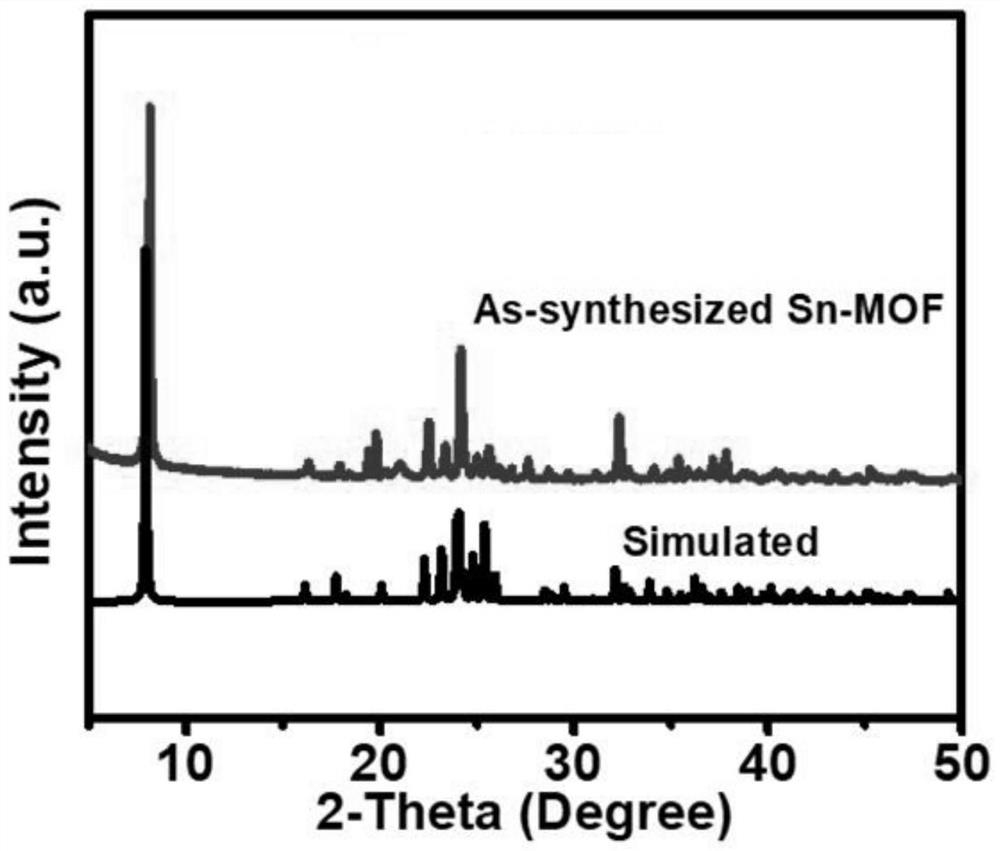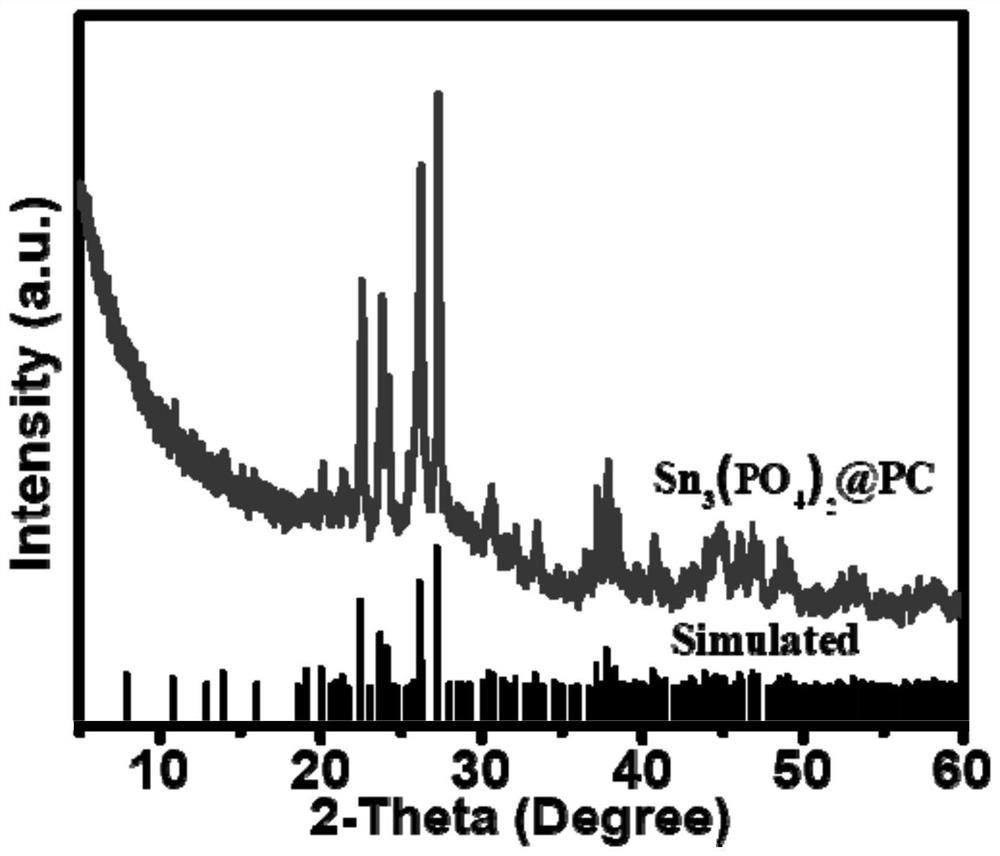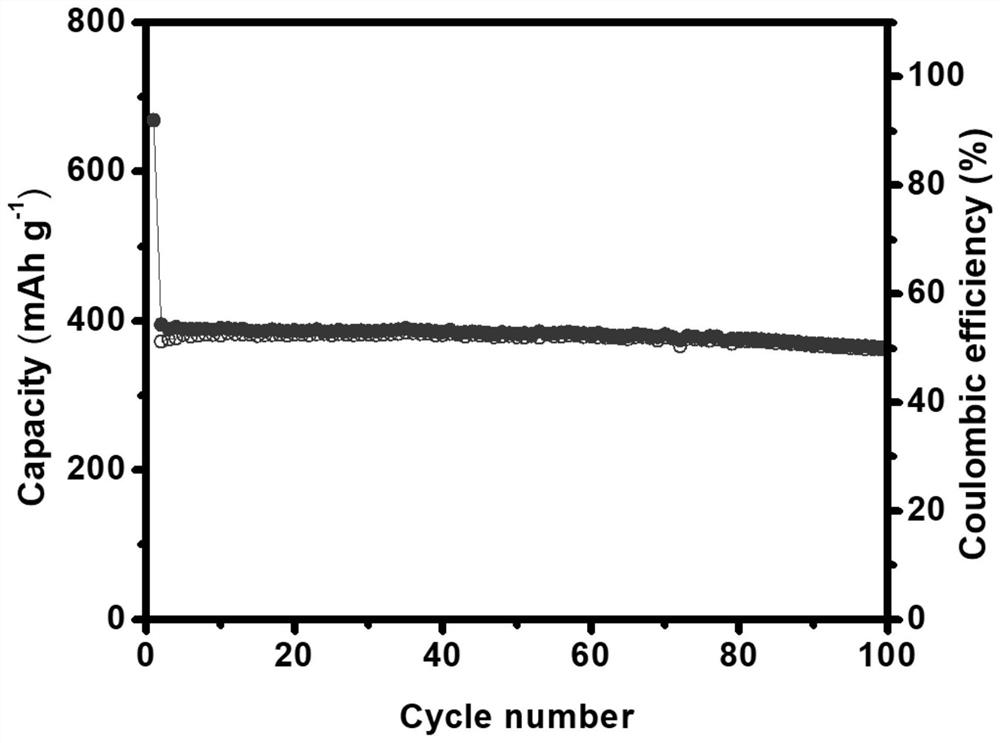Negative electrode material of stannous phosphate battery as well as preparation method and application of negative electrode material
A technology of stannous phosphate and battery negative electrode, which is applied in the direction of battery electrodes, secondary batteries, circuits, etc., can solve the problems of material crushing and large volume change, and achieve the effects of alleviating pulverization, improving cycle life, and low cost
- Summary
- Abstract
- Description
- Claims
- Application Information
AI Technical Summary
Problems solved by technology
Method used
Image
Examples
Embodiment 1
[0032] The invention provides a kind of preparation method of stannous phosphate battery negative electrode material, comprises the following steps:
[0033] Step 1, weigh 1 mmol of stannous oxalate and 1 mmol of p-xylylene diphosphonic acid into a beaker, add 30 mL of deionized water, and fully stir by magnetic stirring to obtain a milky white suspension;
[0034] Step 2, transfer the mixed solution obtained in step 1 to a polytetrafluoroethylene-lined autoclave, heat at 160°C for 48 hours, cool to room temperature, centrifuge, wash, and then in 80°C Dry at high temperature for 10h to obtain a tin-containing phosphonic acid MOF precursor;
[0035] Step 3, put the tin-containing phosphonic acid MOF precursor obtained in step 2 in a tube furnace in a porcelain boat, and feed argon into the tube furnace at a flow rate of 30mL / min. In an argon atmosphere, In the tube furnace, the temperature was raised to 630°C at a constant rate of 20°C / min, then kept for 2 hours, and finally c...
Embodiment 2
[0043] The invention provides a kind of preparation method of stannous phosphate battery negative electrode material, comprises the following steps:
[0044] Step 1: Weigh 1 mmol of stannous chloride and 1 mmol of p-xylylene diphosphonic acid into a beaker, add 30 mL of deionized water, and fully stir by magnetic stirring to obtain a milky white suspension;
[0045] Step 2, transfer the mixed solution obtained in step 1 to a polytetrafluoroethylene-lined autoclave, heat at 160°C for 100h, cool to room temperature, centrifuge, wash, and then in an 80°C Dry at high temperature for 10h to obtain a tin-containing phosphonic acid MOF precursor;
[0046] Step 3, put the tin-containing phosphonic acid MOF precursor obtained in step 2 into a tube furnace in a porcelain boat, and feed nitrogen into the tube furnace at a flow rate of 30mL / min. In an argon atmosphere, the tube furnace In the type furnace, the temperature was raised to 630°C at a constant rate of 20°C / min, and then kept ...
Embodiment 3
[0049] The invention provides a kind of preparation method of stannous phosphate battery negative electrode material, comprises the following steps:
[0050] Step 1, weigh 1 mmol of tin oxalate and 2 mmol of p-xylylene diphosphonic acid into a beaker, add 30 mL of deionized water, and fully stir by magnetic stirring to obtain a milky white suspension;
[0051] Step 2, transfer the mixed solution obtained in step 1 to a polytetrafluoroethylene-lined autoclave, heat at 160°C for 24 hours, cool to room temperature, centrifuge, wash, and then in an 80°C Dry at high temperature for 10h to obtain a tin-containing phosphonic acid MOF precursor;
[0052] Step 3, put the tin-containing phosphonic acid MOF precursor obtained in step 2 in a tube furnace in a porcelain boat, and feed argon into the tube furnace at a flow rate of 30mL / min. In an argon atmosphere, In the tube furnace, the temperature was raised to 550°C at a constant rate of 10°C / min, then kept for 3 hours, and finally coo...
PUM
 Login to View More
Login to View More Abstract
Description
Claims
Application Information
 Login to View More
Login to View More - R&D
- Intellectual Property
- Life Sciences
- Materials
- Tech Scout
- Unparalleled Data Quality
- Higher Quality Content
- 60% Fewer Hallucinations
Browse by: Latest US Patents, China's latest patents, Technical Efficacy Thesaurus, Application Domain, Technology Topic, Popular Technical Reports.
© 2025 PatSnap. All rights reserved.Legal|Privacy policy|Modern Slavery Act Transparency Statement|Sitemap|About US| Contact US: help@patsnap.com



